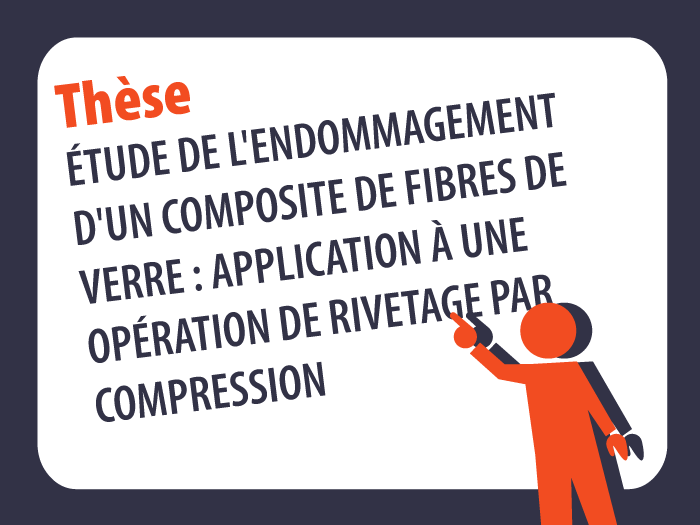
Jeudi 7 juillet 2022, Mme Oumayma Hamlaoui soutiendra à ISAE-Supméca ses travaux de thèse intitulés Étude de l’endommagement d’un composite de fibres de verre : Application à une opération de rivetage par compression et dirigés par MM. Imad Tawfiq et Riadh Elleuch (cotutelle avec l’université de SFAX – Tunisie).
Résumé
Le but de cette thèse est d’étudier l’endommagement d’un composite Polybutylène renforcé en fibres de verre suite à l’application d’une opération de rivetage. L’investigation des composants réels endommagés a permis d’identifier les causes d’endommagement qui étaient en étroite relation avec le taux de fibres important dans la structure. La diminution du taux de renfort dans la structure a été proposée tout en enquêtant sur les répercussions de cette réduction sur les propriétés physiques du composite, notamment l’inflammabilité et la fluidité, caractéristique que veut améliorer parallèlement l’industriel Bulgin, une des parties prenantes de ce sujet de thèse. L’inflammabilité a diminué et la fluidité a augmenté en augmentant le taux de fibre, ce qui influence respectivement le retardement de flamme dans la structure résultat cherchée par l’industriel, afin de garantir la sécurité de l’utilisateur de ses produits et les paramètres réels du processus d’injection qui provoquent des défauts de surface et internes aux pièces composites injectées. L’investigation de l’opération de rivetage a permis une première identification des configurations à un taux de rebus élevé, ces configurations correspondent à celles déployant des composites à taux de renfort élevé. La caractérisation du matériau à différentes vitesses et à différents taux de renfort a reflété respectivement l’absence de viscoélasticité et de viscoplasticité pour ce composite et l’augmentation de la fragilité avec l’augmentation du taux de fibre. Une caractérisation du composite à différents taux de renfort en flexion a montré une variation des propriétés mécaniques en flexion du composite et a confirmé cette augmentation de fragilité. Des essais de flexion cyclique semblables à l’état de chargement réel durant le rivetage a montré l’augmentation des contraintes résiduelles à chaque cycle. L’observation MEB reflétait les micro mécanismes de rupture en fonction de la microstructure des composites à différents taux de renfort. Ces observations MEB ont été appuyées par une analyse microstructurale témoignant des microstructures de la matrice et des fibres, et s’appuyant ainsi sur les mécanismes de rupture préalablement cités.
Mots clés
# Endommagement
# Composite
# Fibre de verre
# Rivetage
# Compression
Abstract
The aim of this thesis is to study the damage of a Polybutylene composite reinforced with fiberglass following the application of a riveting operation. The investigation of the actual damaged components made it possible to identify the causes of damage, which were closely related to the high fiber content in the structure. The reduction in the rate of reinforcement in the structure was proposed while investigating the repercussions of this reduction on the physical properties of the composite, in particular the flammability and the fluidity, something that wants to improve in parallel Bulgin one of the stakeholders of this thesis topic. The flammability decreased, and the fluidity increased by increasing the rate of fiber, which respectively influences the flame retardancy in the structure thing sought by the company Bulgin, in order to guarantee the safety of the user of these products and the parameters of the injection process which cause surface and internal defects in the injected composite parts. The investigation of the riveting operation allowed an initial identification of the configurations with a high scrap rate, these configurations corresponded to those deploying composites with a high reinforcement rate. The characterization of the material at different speeds and at different reinforcement rates respectively reflected the absence of viscoelasticity and viscoplasticity for this composite and the increase in brittleness with the increase of fiber content. A characterization of the composite at different bending reinforcement rates showed a variation in the bending mechanical properties of the composite and confirmed this increase in brittleness. Cyclic bending tests similar to the actual loading state during riveting showed the increase in residual stresses with each cycle. The SEM observation reflected the micro failure mechanisms depending on the microstructure of the composites at different reinforcement rates. These SEM observations were supported by a microstructural analysis showing the microstructures of the matrix and the fibers, thus supporting the failure mechanisms mentioned above.
Key words: Damage, Composite, Glass fiber, Riveting, Compression.










